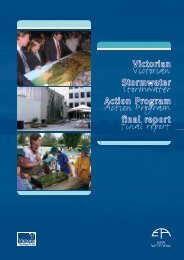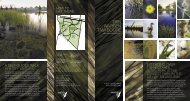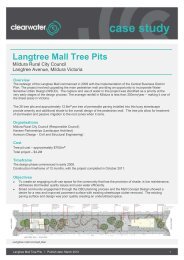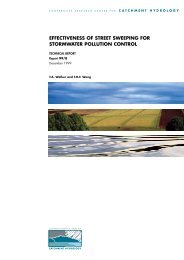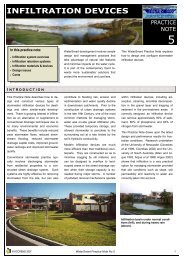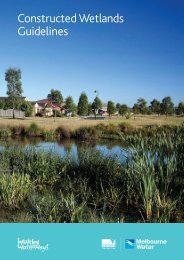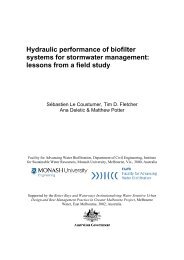Swales and filter strips Operation and Maintenance guide - WSUD
Swales and filter strips Operation and Maintenance guide - WSUD
Swales and filter strips Operation and Maintenance guide - WSUD
Create successful ePaper yourself
Turn your PDF publications into a flip-book with our unique Google optimized e-Paper software.
<strong>Swales</strong> & Filter Strips<br />
<strong>Operation</strong> & Maintanence Guide<br />
STORMWATER DEVICE INFORMATION SERIES
What are swales <strong>and</strong> <strong>filter</strong> <strong>strips</strong>?<br />
<strong>Swales</strong> & Filter Strips <strong>Operation</strong> & Maintanence Guide<br />
STORMWATER DEVICE INFORMATION SERIES<br />
<strong>Swales</strong>, also known as bioretention, <strong>filter</strong> or infiltration <strong>strips</strong>, are broad, grass channels used to<br />
treat stormwater runoff. They direct <strong>and</strong> slow stormwater across grass or similar ground cover<br />
<strong>and</strong> through the soil. <strong>Swales</strong> also help <strong>filter</strong> sediments, nutrients <strong>and</strong> contaminants from incoming<br />
stormwater before discharging to downstream stormwater system or waterways. Some swales have<br />
liners to direct <strong>filter</strong>ed runoff, or rocky linings to slow fast flows. <strong>Swales</strong> are simple to maintain <strong>and</strong><br />
can fit well in urban design.<br />
Fig.1 Swale in Waitakere City
Seven key components of swales <strong>and</strong> <strong>filter</strong> <strong>strips</strong><br />
<strong>Swales</strong> & Filter Strips <strong>Operation</strong> & Maintanence Guide<br />
STORMWATER DEVICE INFORMATION SERIES<br />
1. Inflow points<br />
Stormwater flow<br />
entry, via pipe outlet<br />
or surface runoff.<br />
3. Channel base<br />
Low flow path, may have gravel or rip<br />
rap reinforcing to prevent erosion.<br />
5. Plants <strong>and</strong> soil<br />
Grass or other low lying plants in<br />
permeable soil for <strong>filter</strong>ing stormwater.<br />
edge strip<br />
slotted curb<br />
car park<br />
2. Side slopes<br />
Total channel width. Slope less than<br />
3:1 for mower access <strong>and</strong> to prevent<br />
scour.<br />
well draining soil<br />
4. Underdrain (if present)<br />
Usually perforated pipe, buried<br />
under channel to capture <strong>filter</strong>ed<br />
flow <strong>and</strong> connected to stormwater<br />
system.<br />
6. Outlet<br />
Discharge point for <strong>filter</strong>ed<br />
stormwater.<br />
7. Flow controls<br />
Check dams or spreaders, used<br />
to slow <strong>and</strong> spread flows to<br />
improve <strong>filter</strong>ing. Often used<br />
on swales with slopes over 5%.<br />
2
<strong>Swales</strong> & Filter Strips <strong>Operation</strong> & Maintanence Guide<br />
STORMWATER DEVICE INFORMATION SERIES<br />
Fig.2 Waitakere City Hospital car<br />
park swale<br />
• Slotted kerbs not too close to edge of swale.<br />
• Sign post in centre of swale are compromising underdrain.<br />
Fig.4 Manawa Wetl<strong>and</strong> vegetated swale<br />
• Native vegetated swale following contours <strong>and</strong> overl<strong>and</strong> flow paths.<br />
• Check dams used to slow flow <strong>and</strong> allow for filtration.<br />
Fig.3 Henderson Valley Road<br />
– newly constructed road side swales<br />
• Geotextile used to protect catchpit (swale outlet) during construction.<br />
• Dish channels for each driveway controls flows <strong>and</strong> allow high flows to<br />
pass above.<br />
3
MAINTENANCE SCHEDULE<br />
<strong>Swales</strong> & Filter Strips <strong>Operation</strong> & Maintanence Guide<br />
STORMWATER DEVICE INFORMATION SERIES<br />
TIMING COMPONENT ACTION<br />
Following<br />
storms<br />
Monthly<br />
Two yearly<br />
Inflow points<br />
Side slopes<br />
Channel base<br />
Plants <strong>and</strong> soil<br />
Outlet<br />
Inflow points<br />
Channel base<br />
Plants <strong>and</strong> soil<br />
Outlet<br />
Channel base<br />
Grass, plants <strong>and</strong> soil<br />
• Check for scouring, channelling <strong>and</strong> erosion, <strong>and</strong> repair as necessary.<br />
• Check for scouring, channelling <strong>and</strong> erosion, <strong>and</strong> repair by adding<br />
soil <strong>and</strong> replanting as necessary.<br />
• Check for scouring, channelling <strong>and</strong> erosion, <strong>and</strong> repair by adding<br />
soil <strong>and</strong> replanting as necessary.<br />
• Check stormwater is <strong>filter</strong>ing though soil following storm runoff.<br />
• Remove weeds.<br />
• Check outlet for scouring or erosion <strong>and</strong> repair to suit.<br />
• Remove rubbish <strong>and</strong> debris.<br />
• If grassed, mow channel no shorter than 150mm length.<br />
• Use catcher <strong>and</strong> remove clippings.<br />
• Re-seed bare patches of grass <strong>and</strong> water in dry conditions to establish.<br />
• If planted, check plants are healthy <strong>and</strong> growth is dense.<br />
• Remove weeds.<br />
• Replant gaps <strong>and</strong> water new plants in dry conditions until established.<br />
• Remove rubbish <strong>and</strong> debris from outlet grate or catchpit.<br />
• Check for boggy patches <strong>and</strong> ponding water.<br />
• Check soil is not compacted, <strong>and</strong> aerate surface or top up dips to repair.<br />
• Remove weeds, rubbish <strong>and</strong> debris.<br />
• Replant gaps <strong>and</strong> re-seed bare patches, <strong>and</strong> water if required to establish.<br />
• Aerate soil to prevent natural compaction, similar to coring sportsfields <strong>and</strong><br />
lawn bowls greens.<br />
• Check stormwater is <strong>filter</strong>ing though soil, by either monitoring after storm<br />
runoff or by running water across swale.<br />
4
Troubleshooting<br />
<strong>Swales</strong> & Filter Strips <strong>Operation</strong> & Maintanence Guide<br />
STORMWATER DEVICE INFORMATION SERIES<br />
SYMPTOM POSSIBLE PROBLEMS SOLUTION<br />
Water not draining.<br />
Ponding<br />
Water flowing<br />
straight to<br />
outlet<br />
Soil compacted<br />
Soil clogged with fine sediments<br />
Underdrain, if present, may be blocked – check<br />
for discharge at outlet.<br />
Soil not free-draining.<br />
Swale slope too steep.<br />
• Aerate soil with rotating aerator or core, as for sports fields.<br />
• Remove top layer of soil <strong>and</strong> replace, turning soil.<br />
• Re build underdrain.<br />
• See above - aerate soil, replace top layer of soil, replace soil with free draining mix.<br />
• If slope over 5%, construct check dams to slow flows.<br />
Plants or grass not dense enough.<br />
• Leave grass longer, <strong>and</strong> re-seed to increase density. Mow less frequently during<br />
dry periods.<br />
Scouring /<br />
Channels appearing<br />
Inflow concentrated at inlets.<br />
• Remove blockages including rubbish, debris <strong>and</strong> sediment build up.<br />
• Fill channels as necessary, replanting.<br />
5
<strong>Swales</strong> & Filter Strips <strong>Operation</strong> & Maintanence Guide<br />
STORMWATER DEVICE INFORMATION SERIES<br />
Quick maintenance check<br />
Maintain grass length to between 50-150mm.<br />
Avoid<br />
On roadside swales, keep plant height below line-of-sight for<br />
motorists .<br />
Disclaimer<br />
This publication is provided strictly subject to Auckl<strong>and</strong> Council’s (AC) copyright <strong>and</strong> other intellectual property rights (if any) in the publication.<br />
Users of the publication may only access, reproduce <strong>and</strong> use the publication, in a secure digital medium or hard copy, for responsible genuine noncommercial<br />
purposes relating to personal, public service or educational purposes, provided that the publication is only ever accurately reproduced <strong>and</strong><br />
proper attribution of its source, publication date <strong>and</strong> authorship is attached to any use or reproduction. This publication must not be used in any way<br />
for any commercial purpose without the prior written consent of AC. AC does not give any warranty whatsoever, including without limitation, as to the<br />
availability, accuracy, completeness, currency or reliability of the information or data (including third party data) made available via the publication <strong>and</strong><br />
expressly disclaim (to the maximum extent permitted in law) all liability for any damage or loss resulting from your use of, or reliance on the publication<br />
or the information <strong>and</strong> data provided via the publication. The publication <strong>and</strong> information <strong>and</strong> data contained within it are provided on an “as is” basis.




